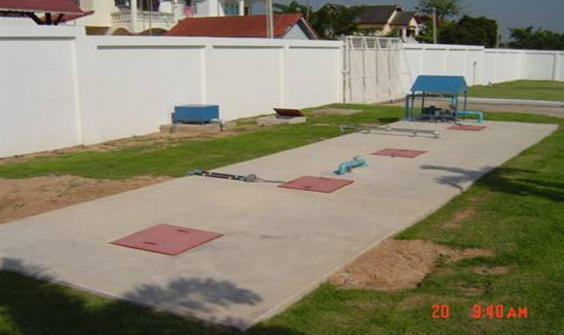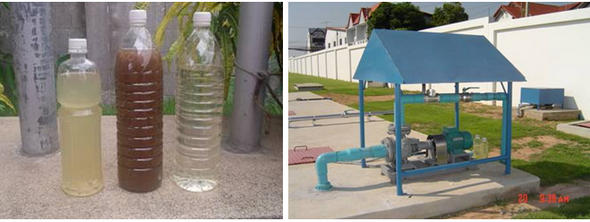Wastewater Treatment
ระบบบำบัดน้ำเสีย ระบบกำจัดไขมัน และน้ำมัน ระบบบำบัดน้ำเสียด้วยวิธีทางเคมี (Chemical Treatment System) ระบบบำบัดน้ำเสียด้วยวิธีทางชีวภาพ (Biological Treatment System)
Sequence Batch Reactor
Sequencing batch reactors (SBR) or sequential batch reactors are industrial processing tanks for the treatment of wastewater. SBR reactors treat waste water such as sewage or output from anaerobic digesters or mechanical biological treatment facilities in batches. Oxygen is bubbled through the waste water to reduce biochemical oxygen demand (BOD) and chemical oxygen demand (COD) to make suitable for discharge into sewers or for use on land.
While there are several configurations of SBRs the basic process is similar. The installation consists of at least two identically equipped tanks with a common inlet, which can be switched between them. The tanks have a “flow through” system, with raw wastewater (influent) coming in at one end and treated water (effluent) flowing out the other. While one tank is in settle/decant mode the other is aerating and filling. At the inlet is a section of the tank known as the bio-selector. This consists of a series of walls or baffles which direct the flow either from side to side of the tank or under and over consecutive baffles. This helps to mix the incoming Influent and the returned activated sludge, beginning the biological digestion process before the liquor enters the main part of the tank.
There are four stages to treatment, fill, aeration, settling and decanting. The aeration stage involves adding air to the mixed solids and liquid either by the use of fixed or floating mechanical pumps or by blowing it into finely perforated membranes fixed to the floor of the tank. During this period the inlet valve to the tank is open and a returned activated sludge pump takes mixed liquid and solids (mixed liquor) from the outlet end of the tank to the inlet. This “seeds” the incoming sewage with live bacteria.
Aeration times vary according to the plant size and the composition/quantity of the incoming liquor, but are typically 60 – 90 minutes. The addition of oxygen to the liquor encourages the multiplication of aerobic bacteria and they consume the nutrients. This process encourages the production of nitrogen compounds as the bacteria increase their number, a process known as nitrification.
To remove phosphorus compounds from the liquor aluminium sulfate (alum) is often added during this period. It reacts to form non-soluble compounds, which settle into the sludge in the next stage.
The settling stage is usually the same length in time as the aeration. During this stage the sludge formed by the bacteria is allowed to settle to the bottom of the tank. The aerobic bacteria continue to multiply until the dissolved oxygen is all but used up. Conditions in the tank, especially near the bottom are now more suitable for the anaerobic bacteria to flourish. Many of these, and some of the bacteria which would prefer an oxygen environment, now start to use nitrogen as a base element and extract it from the compounds in the liquid, using up the nitrogen compounds created in the aeration stage. This is known as denitrification.
As the bacteria multiply and die, the sludge within the tank increases over time and a waste activated sludge pump removes some of the sludge during the settle stage to a digester for further treatment. The quantity or “age” of sludge within the tank is closely monitored, as this can have a marked effect on the treatment process.
The sludge is allowed to settle until clear water is on the top 20%-30% of the tank contents.
The decanting stage most commonly involves the slow lowering of a scoop or “trough” into the basin. This has a piped connection to a lagoon where the final effluent is stored for disposal to a wetland, tree growing lot, ocean outfall, or to be further treated for use on parks, golf courses etc.





